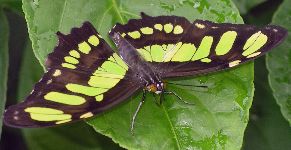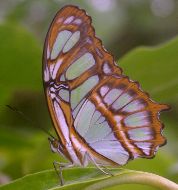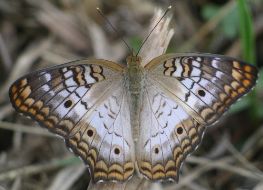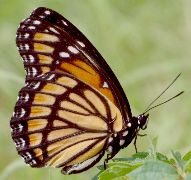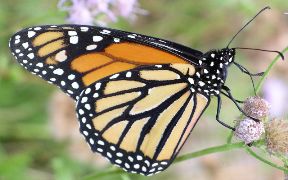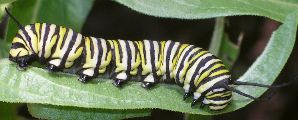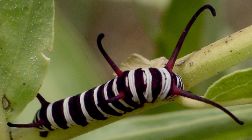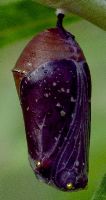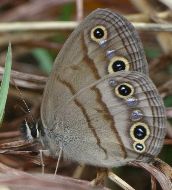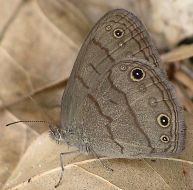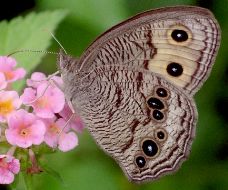
| Nymphalidae ~ Brush-footed Butterflies |
page 1 ![]() page 2
page 2 ![]() page 3
page 3 ![]() page 4
page 4 ![]() page 5
page 5
I often hear of other people seeing spectacular and rare strays that make it into our area but that I never encounter. One of these is the Malachite (Siproeta stelenes), a lovely green nymphalid that cannot be mistaken for any other species. Although I've only seen these in Florida, others have assured me that they occur here in Austin, so I've included the species here. The undersides of the wings are not so much green as light aqua color, and the black lines of the upper sides of the wings are mirrored in light brown on the underside.
While I'm using photos that were not taken locally, I'll also include the White Peacock (Anartia jatrophae), a finely marked light gray butterfly that shows up occasionally here. I have seen and even photographed them here in Austin, but the individuals that I've encountered have all be pretty tattered. I can't resist showing a fresh specimen, seen in Florida, as the photo is far more aesthetically pleasing. This species only shows up in the autumn and can usually be found fluttering around flowers.
Although the Viceroy (Limenitis archippus) is not closely related to the Monarch (Danaus plexippus), it helps to see their images together for identification purposes. The Viceroy was at one time thought to simply mimic the distasteful Monarch, which gains its poisonous taste from a larval diet of milkweeds. However, it is now generally thought that both taste equally bad to birds, and the warning colors are presented with good reason. The easiest clues to remember about identifying the Viceroy is that it has a continuous black line across the hind wings and that it is rather smaller than the Monarch. It is also not nearly as commonly seen in our area.
Both the Monarch and the closely related Queen (Danaus gilippus) are known as milkweed butterflies and that is the only kind of plant on which the larvae feed. Both species are quite common here; the darker brown color on the undersides of the wings, lack of heavy black veins on the tops, and smaller size distinguish the Queen from the Monarch.
There is another similar butterfly, the Soldier (Danaus eresimus), which is almost indistinguishable at a glance from the Queen. This species strays up from Mexico in the autumn of most years, usually appearing in the same places as both Queens and Monarchs but being much less numerous. The main features that distinguish the Soldier from the Queen are smudges on the underside of the hind wing and lack of the big white dots towards the outer edge of the upper wing, most easily seen on the top side. The males and females of Queens, Soldiers, and Monarchs look quite similar. However, there is a small black spot each hind wing of the males. On the Monarch, it blends in with one of the veins but on the Queen it is a prominent black spot on top and a white spot surrounded by black on the underside. The purpose of this area is to produce pheromones used in courting. The male Queens and Soldiers also seek out chemicals present in the flowers of plants in the genus Eupatorium. During the summer and fall, Greg's Mistflower (Eupatorium greggii) is especially attractive, and dry seed heads seem to attract more butterflies than fresh flowers!
The caterpillars of the milkweed butterflies are smooth with no spines. They do, however, have fleshy appendages. There are four of these on Monarchs and six on Queens. Otherwise, the color patterns are similar, with red, white and yellow bands. During cold weather, the Monarch larvae tend to be much darker, sometimes nearly all black. There is also a dark form of the Queen caterpillar, but it doesn't seem to have anything to do with temperature.
When ready to pupate, milkweed caterpillars attach by the rear to a leaf or other structure and hang upside down. They molt into one of the most familiar of all chrysalises: the jewel-like smooth green pupa with gold dots that is pictured in every book on butterflies ever written. The pupae really are gorgeous, and they are only camouflaged if the leaf on which they are attached stays alive. On dead stems, the green pupae are easily spotted. Just before the adult emerges, the chrysalis becomes clear and the markings of the butterfly can be seen inside. At this point, it is possible to tell a Monarch from a Queen, although their general shape is quite similar. There is one more small subfamily of nymphalids and that includes the satyrs. These are small brown butterflies that prefer woodlands to open fields and do not visit flowers. They are not terribly common, but they do occur regularly in forested areas around Austin. I've seen two species of satyr, the Little Wood-satyr (Megisto cymela) and the Carolina Satyr (Hermeuptychia sosybius). These small butterflies are usually seen resting with wings closed on dead leaves on the ground. Their markings are quite similar, but the Little Wood-satyr has an extra eyespot on the underside of the forewing, and in general the eyespots are larger than on the Carolina Satyr.
One other member of this group is the Common Wood-nymph (Cercyonis pegala), which can be common but is not found in many places. It is a much larger species than the satyrs, but also prefers wooded areas. It does, however, sometimes feed at flowers as well as on fruit or sap. This species occurs throughout much of the U.S. and one color variation is the norm for here in Austin: the forewings have a large yellow area around the eyespots. |
page 1 ![]() page 2
page 2 ![]() page 3
page 3 ![]() page 4
page 4 ![]() page 5
page 5
![]()
